A Detailed Operations Management Report on Toyota Motors Corporation
VerifiedAdded on 2022/08/24
|20
|5546
|14
Report
AI Summary
This report provides a comprehensive analysis of Toyota Motors Corporation's operations management. It begins with an introduction to operations management and a brief overview of Toyota, including its operational principles and how its strategy aligns with its corporate goals. The report delves into Toyota's operations strategy, examining its current approaches and proposing both current and long-term solutions to address the company's challenges, supported by real-world examples. It then explores three supply chain management strategies that contribute to business success and profitability, again with examples. Furthermore, the report discusses quality management approaches applicable to Toyota's operations, including both offline and online quality management tools, and provides examples of their implementation. The report concludes with an analysis of how a Big Data-driven AI platform can enhance overall business operations, discussing the potential business exposures and risks within Toyota's operations strategy, and provides illustrative examples. The report is a student's contribution to Desklib, offering valuable insights into Toyota's operational practices and strategies.
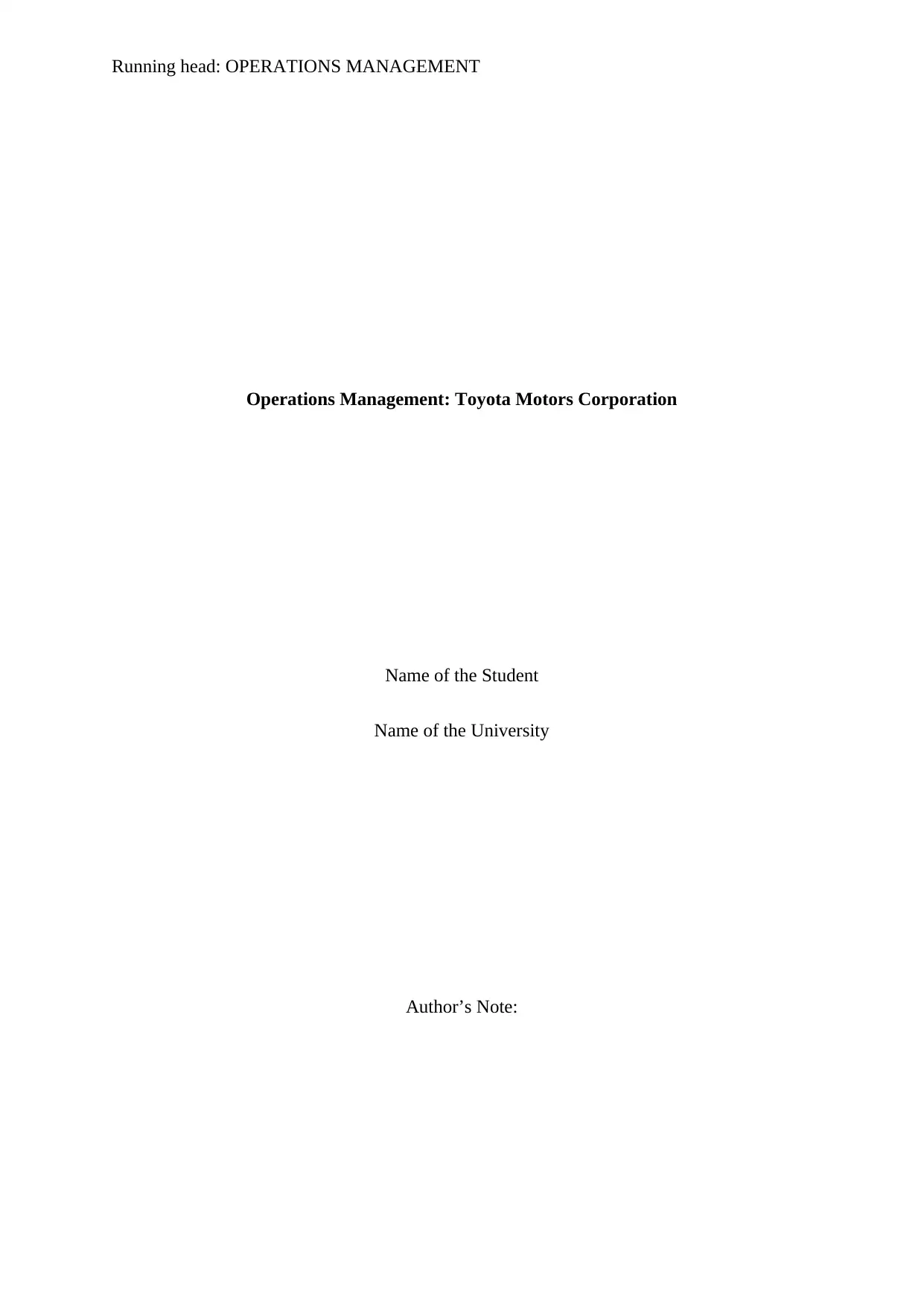
Running head: OPERATIONS MANAGEMENT
Operations Management: Toyota Motors Corporation
Name of the Student
Name of the University
Author’s Note:
Operations Management: Toyota Motors Corporation
Name of the Student
Name of the University
Author’s Note:
Paraphrase This Document
Need a fresh take? Get an instant paraphrase of this document with our AI Paraphraser
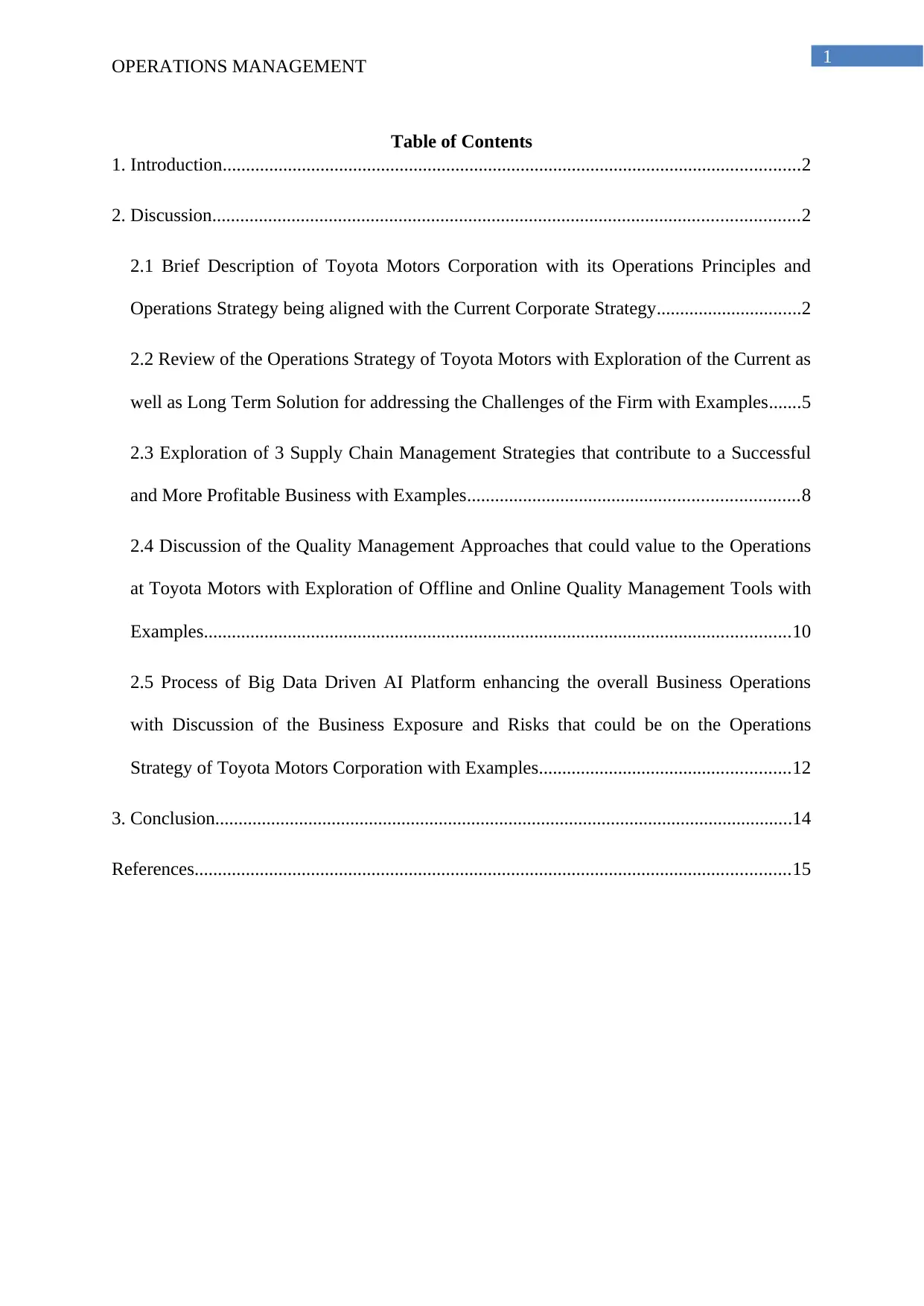
1
OPERATIONS MANAGEMENT
Table of Contents
1. Introduction............................................................................................................................2
2. Discussion..............................................................................................................................2
2.1 Brief Description of Toyota Motors Corporation with its Operations Principles and
Operations Strategy being aligned with the Current Corporate Strategy...............................2
2.2 Review of the Operations Strategy of Toyota Motors with Exploration of the Current as
well as Long Term Solution for addressing the Challenges of the Firm with Examples.......5
2.3 Exploration of 3 Supply Chain Management Strategies that contribute to a Successful
and More Profitable Business with Examples.......................................................................8
2.4 Discussion of the Quality Management Approaches that could value to the Operations
at Toyota Motors with Exploration of Offline and Online Quality Management Tools with
Examples..............................................................................................................................10
2.5 Process of Big Data Driven AI Platform enhancing the overall Business Operations
with Discussion of the Business Exposure and Risks that could be on the Operations
Strategy of Toyota Motors Corporation with Examples......................................................12
3. Conclusion............................................................................................................................14
References................................................................................................................................15
OPERATIONS MANAGEMENT
Table of Contents
1. Introduction............................................................................................................................2
2. Discussion..............................................................................................................................2
2.1 Brief Description of Toyota Motors Corporation with its Operations Principles and
Operations Strategy being aligned with the Current Corporate Strategy...............................2
2.2 Review of the Operations Strategy of Toyota Motors with Exploration of the Current as
well as Long Term Solution for addressing the Challenges of the Firm with Examples.......5
2.3 Exploration of 3 Supply Chain Management Strategies that contribute to a Successful
and More Profitable Business with Examples.......................................................................8
2.4 Discussion of the Quality Management Approaches that could value to the Operations
at Toyota Motors with Exploration of Offline and Online Quality Management Tools with
Examples..............................................................................................................................10
2.5 Process of Big Data Driven AI Platform enhancing the overall Business Operations
with Discussion of the Business Exposure and Risks that could be on the Operations
Strategy of Toyota Motors Corporation with Examples......................................................12
3. Conclusion............................................................................................................................14
References................................................................................................................................15
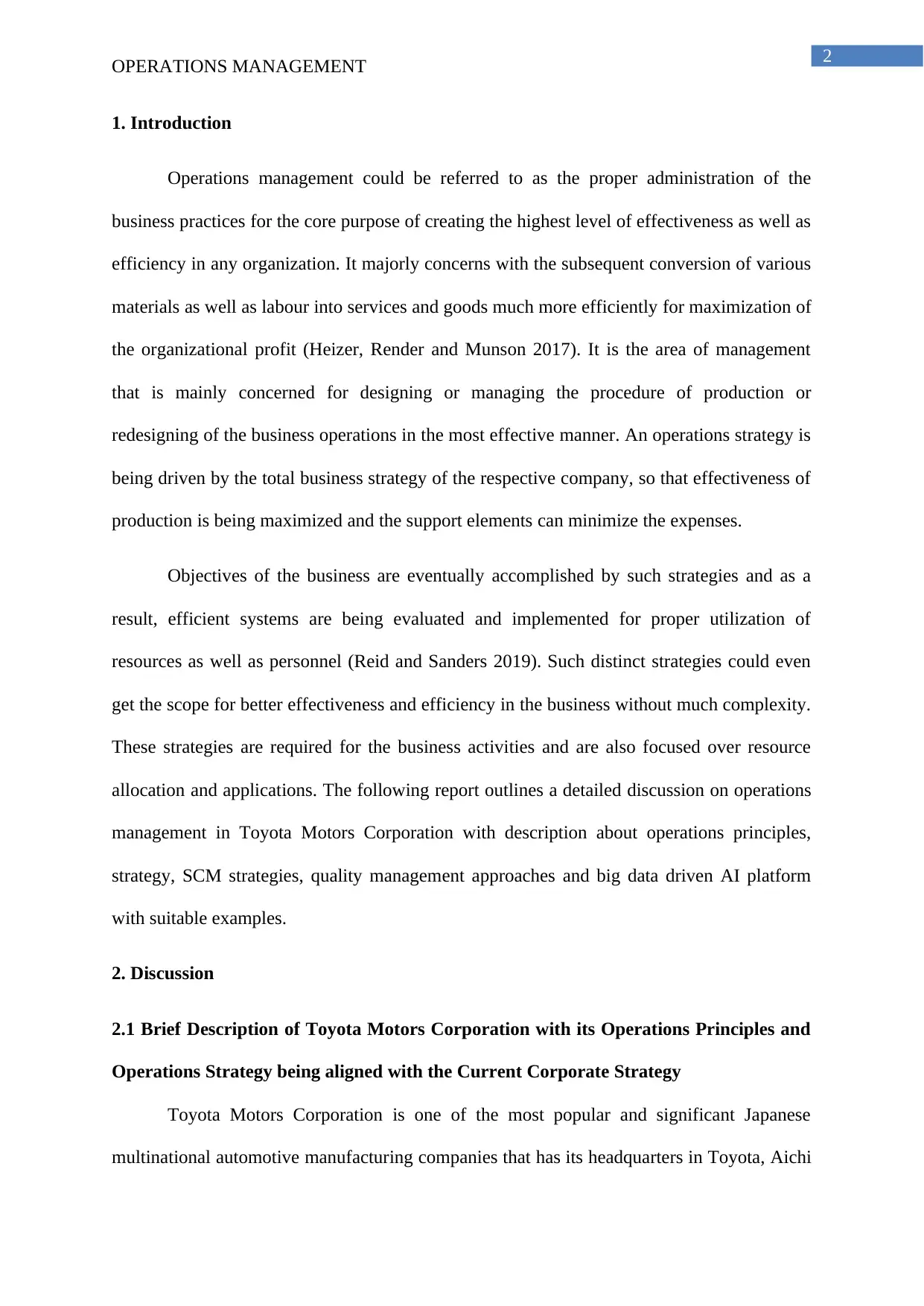
2
OPERATIONS MANAGEMENT
1. Introduction
Operations management could be referred to as the proper administration of the
business practices for the core purpose of creating the highest level of effectiveness as well as
efficiency in any organization. It majorly concerns with the subsequent conversion of various
materials as well as labour into services and goods much more efficiently for maximization of
the organizational profit (Heizer, Render and Munson 2017). It is the area of management
that is mainly concerned for designing or managing the procedure of production or
redesigning of the business operations in the most effective manner. An operations strategy is
being driven by the total business strategy of the respective company, so that effectiveness of
production is being maximized and the support elements can minimize the expenses.
Objectives of the business are eventually accomplished by such strategies and as a
result, efficient systems are being evaluated and implemented for proper utilization of
resources as well as personnel (Reid and Sanders 2019). Such distinct strategies could even
get the scope for better effectiveness and efficiency in the business without much complexity.
These strategies are required for the business activities and are also focused over resource
allocation and applications. The following report outlines a detailed discussion on operations
management in Toyota Motors Corporation with description about operations principles,
strategy, SCM strategies, quality management approaches and big data driven AI platform
with suitable examples.
2. Discussion
2.1 Brief Description of Toyota Motors Corporation with its Operations Principles and
Operations Strategy being aligned with the Current Corporate Strategy
Toyota Motors Corporation is one of the most popular and significant Japanese
multinational automotive manufacturing companies that has its headquarters in Toyota, Aichi
OPERATIONS MANAGEMENT
1. Introduction
Operations management could be referred to as the proper administration of the
business practices for the core purpose of creating the highest level of effectiveness as well as
efficiency in any organization. It majorly concerns with the subsequent conversion of various
materials as well as labour into services and goods much more efficiently for maximization of
the organizational profit (Heizer, Render and Munson 2017). It is the area of management
that is mainly concerned for designing or managing the procedure of production or
redesigning of the business operations in the most effective manner. An operations strategy is
being driven by the total business strategy of the respective company, so that effectiveness of
production is being maximized and the support elements can minimize the expenses.
Objectives of the business are eventually accomplished by such strategies and as a
result, efficient systems are being evaluated and implemented for proper utilization of
resources as well as personnel (Reid and Sanders 2019). Such distinct strategies could even
get the scope for better effectiveness and efficiency in the business without much complexity.
These strategies are required for the business activities and are also focused over resource
allocation and applications. The following report outlines a detailed discussion on operations
management in Toyota Motors Corporation with description about operations principles,
strategy, SCM strategies, quality management approaches and big data driven AI platform
with suitable examples.
2. Discussion
2.1 Brief Description of Toyota Motors Corporation with its Operations Principles and
Operations Strategy being aligned with the Current Corporate Strategy
Toyota Motors Corporation is one of the most popular and significant Japanese
multinational automotive manufacturing companies that has its headquarters in Toyota, Aichi
⊘ This is a preview!⊘
Do you want full access?
Subscribe today to unlock all pages.

Trusted by 1+ million students worldwide
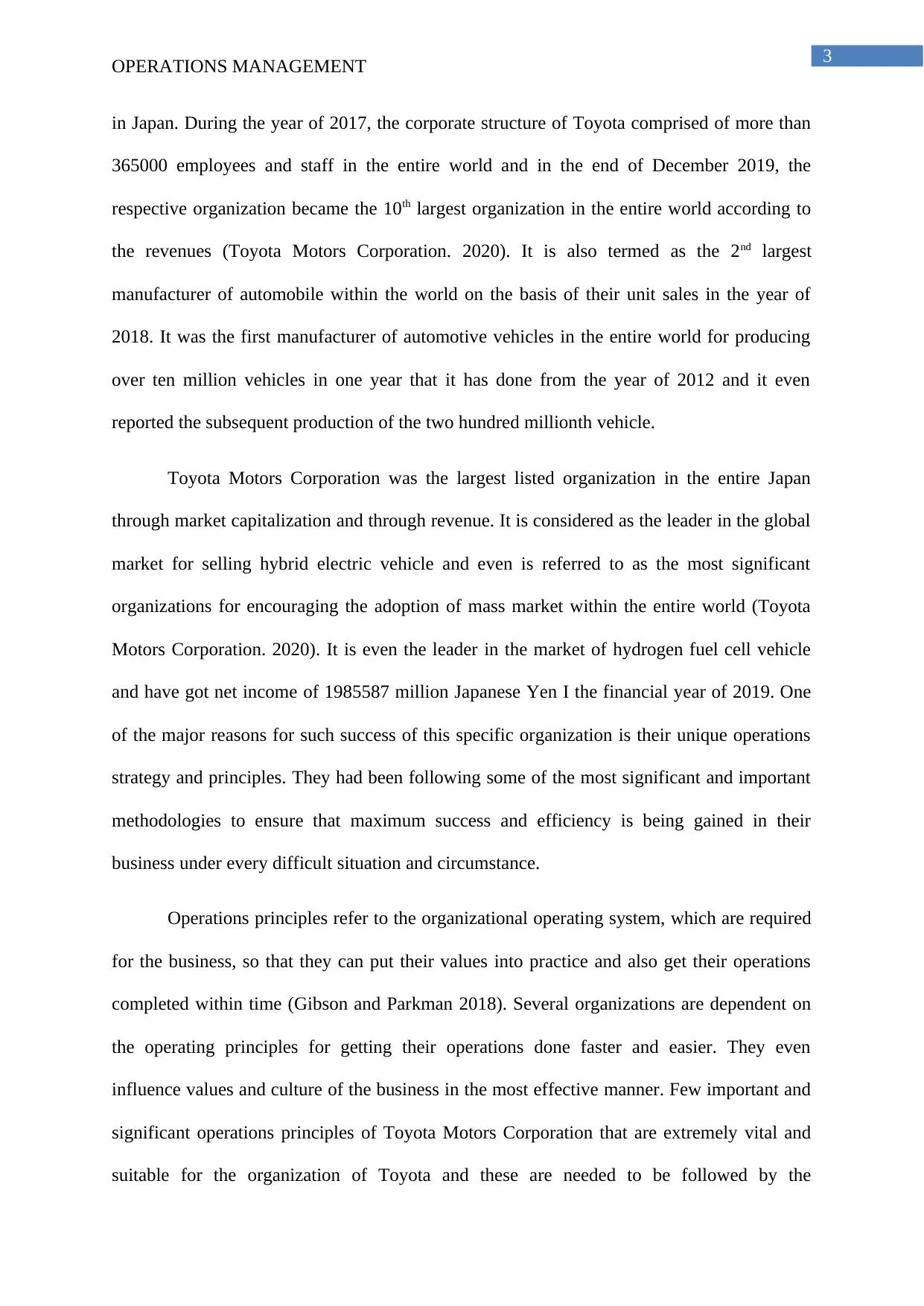
3
OPERATIONS MANAGEMENT
in Japan. During the year of 2017, the corporate structure of Toyota comprised of more than
365000 employees and staff in the entire world and in the end of December 2019, the
respective organization became the 10th largest organization in the entire world according to
the revenues (Toyota Motors Corporation. 2020). It is also termed as the 2nd largest
manufacturer of automobile within the world on the basis of their unit sales in the year of
2018. It was the first manufacturer of automotive vehicles in the entire world for producing
over ten million vehicles in one year that it has done from the year of 2012 and it even
reported the subsequent production of the two hundred millionth vehicle.
Toyota Motors Corporation was the largest listed organization in the entire Japan
through market capitalization and through revenue. It is considered as the leader in the global
market for selling hybrid electric vehicle and even is referred to as the most significant
organizations for encouraging the adoption of mass market within the entire world (Toyota
Motors Corporation. 2020). It is even the leader in the market of hydrogen fuel cell vehicle
and have got net income of 1985587 million Japanese Yen I the financial year of 2019. One
of the major reasons for such success of this specific organization is their unique operations
strategy and principles. They had been following some of the most significant and important
methodologies to ensure that maximum success and efficiency is being gained in their
business under every difficult situation and circumstance.
Operations principles refer to the organizational operating system, which are required
for the business, so that they can put their values into practice and also get their operations
completed within time (Gibson and Parkman 2018). Several organizations are dependent on
the operating principles for getting their operations done faster and easier. They even
influence values and culture of the business in the most effective manner. Few important and
significant operations principles of Toyota Motors Corporation that are extremely vital and
suitable for the organization of Toyota and these are needed to be followed by the
OPERATIONS MANAGEMENT
in Japan. During the year of 2017, the corporate structure of Toyota comprised of more than
365000 employees and staff in the entire world and in the end of December 2019, the
respective organization became the 10th largest organization in the entire world according to
the revenues (Toyota Motors Corporation. 2020). It is also termed as the 2nd largest
manufacturer of automobile within the world on the basis of their unit sales in the year of
2018. It was the first manufacturer of automotive vehicles in the entire world for producing
over ten million vehicles in one year that it has done from the year of 2012 and it even
reported the subsequent production of the two hundred millionth vehicle.
Toyota Motors Corporation was the largest listed organization in the entire Japan
through market capitalization and through revenue. It is considered as the leader in the global
market for selling hybrid electric vehicle and even is referred to as the most significant
organizations for encouraging the adoption of mass market within the entire world (Toyota
Motors Corporation. 2020). It is even the leader in the market of hydrogen fuel cell vehicle
and have got net income of 1985587 million Japanese Yen I the financial year of 2019. One
of the major reasons for such success of this specific organization is their unique operations
strategy and principles. They had been following some of the most significant and important
methodologies to ensure that maximum success and efficiency is being gained in their
business under every difficult situation and circumstance.
Operations principles refer to the organizational operating system, which are required
for the business, so that they can put their values into practice and also get their operations
completed within time (Gibson and Parkman 2018). Several organizations are dependent on
the operating principles for getting their operations done faster and easier. They even
influence values and culture of the business in the most effective manner. Few important and
significant operations principles of Toyota Motors Corporation that are extremely vital and
suitable for the organization of Toyota and these are needed to be followed by the
Paraphrase This Document
Need a fresh take? Get an instant paraphrase of this document with our AI Paraphraser
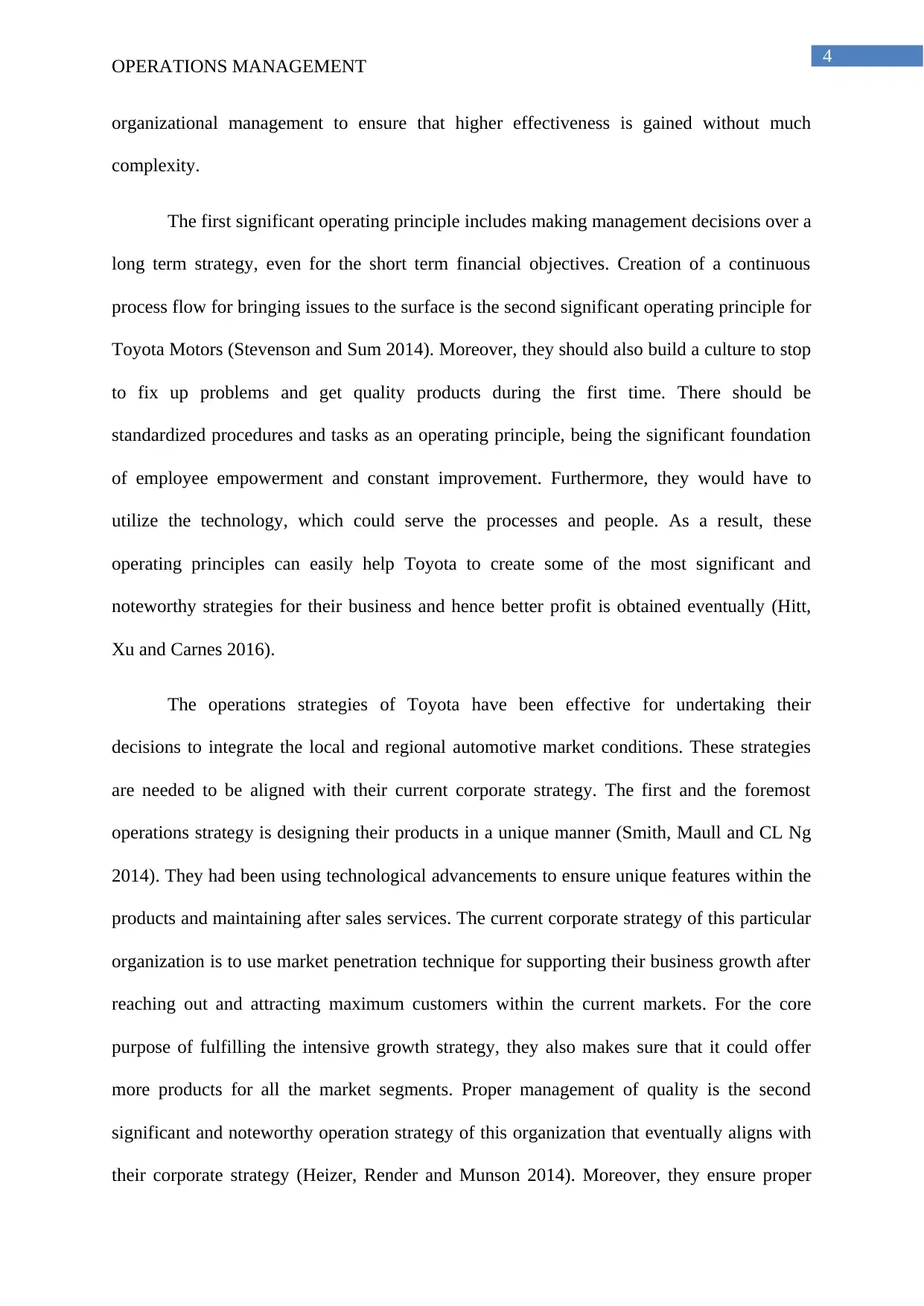
4
OPERATIONS MANAGEMENT
organizational management to ensure that higher effectiveness is gained without much
complexity.
The first significant operating principle includes making management decisions over a
long term strategy, even for the short term financial objectives. Creation of a continuous
process flow for bringing issues to the surface is the second significant operating principle for
Toyota Motors (Stevenson and Sum 2014). Moreover, they should also build a culture to stop
to fix up problems and get quality products during the first time. There should be
standardized procedures and tasks as an operating principle, being the significant foundation
of employee empowerment and constant improvement. Furthermore, they would have to
utilize the technology, which could serve the processes and people. As a result, these
operating principles can easily help Toyota to create some of the most significant and
noteworthy strategies for their business and hence better profit is obtained eventually (Hitt,
Xu and Carnes 2016).
The operations strategies of Toyota have been effective for undertaking their
decisions to integrate the local and regional automotive market conditions. These strategies
are needed to be aligned with their current corporate strategy. The first and the foremost
operations strategy is designing their products in a unique manner (Smith, Maull and CL Ng
2014). They had been using technological advancements to ensure unique features within the
products and maintaining after sales services. The current corporate strategy of this particular
organization is to use market penetration technique for supporting their business growth after
reaching out and attracting maximum customers within the current markets. For the core
purpose of fulfilling the intensive growth strategy, they also makes sure that it could offer
more products for all the market segments. Proper management of quality is the second
significant and noteworthy operation strategy of this organization that eventually aligns with
their corporate strategy (Heizer, Render and Munson 2014). Moreover, they ensure proper
OPERATIONS MANAGEMENT
organizational management to ensure that higher effectiveness is gained without much
complexity.
The first significant operating principle includes making management decisions over a
long term strategy, even for the short term financial objectives. Creation of a continuous
process flow for bringing issues to the surface is the second significant operating principle for
Toyota Motors (Stevenson and Sum 2014). Moreover, they should also build a culture to stop
to fix up problems and get quality products during the first time. There should be
standardized procedures and tasks as an operating principle, being the significant foundation
of employee empowerment and constant improvement. Furthermore, they would have to
utilize the technology, which could serve the processes and people. As a result, these
operating principles can easily help Toyota to create some of the most significant and
noteworthy strategies for their business and hence better profit is obtained eventually (Hitt,
Xu and Carnes 2016).
The operations strategies of Toyota have been effective for undertaking their
decisions to integrate the local and regional automotive market conditions. These strategies
are needed to be aligned with their current corporate strategy. The first and the foremost
operations strategy is designing their products in a unique manner (Smith, Maull and CL Ng
2014). They had been using technological advancements to ensure unique features within the
products and maintaining after sales services. The current corporate strategy of this particular
organization is to use market penetration technique for supporting their business growth after
reaching out and attracting maximum customers within the current markets. For the core
purpose of fulfilling the intensive growth strategy, they also makes sure that it could offer
more products for all the market segments. Proper management of quality is the second
significant and noteworthy operation strategy of this organization that eventually aligns with
their corporate strategy (Heizer, Render and Munson 2014). Moreover, they ensure proper
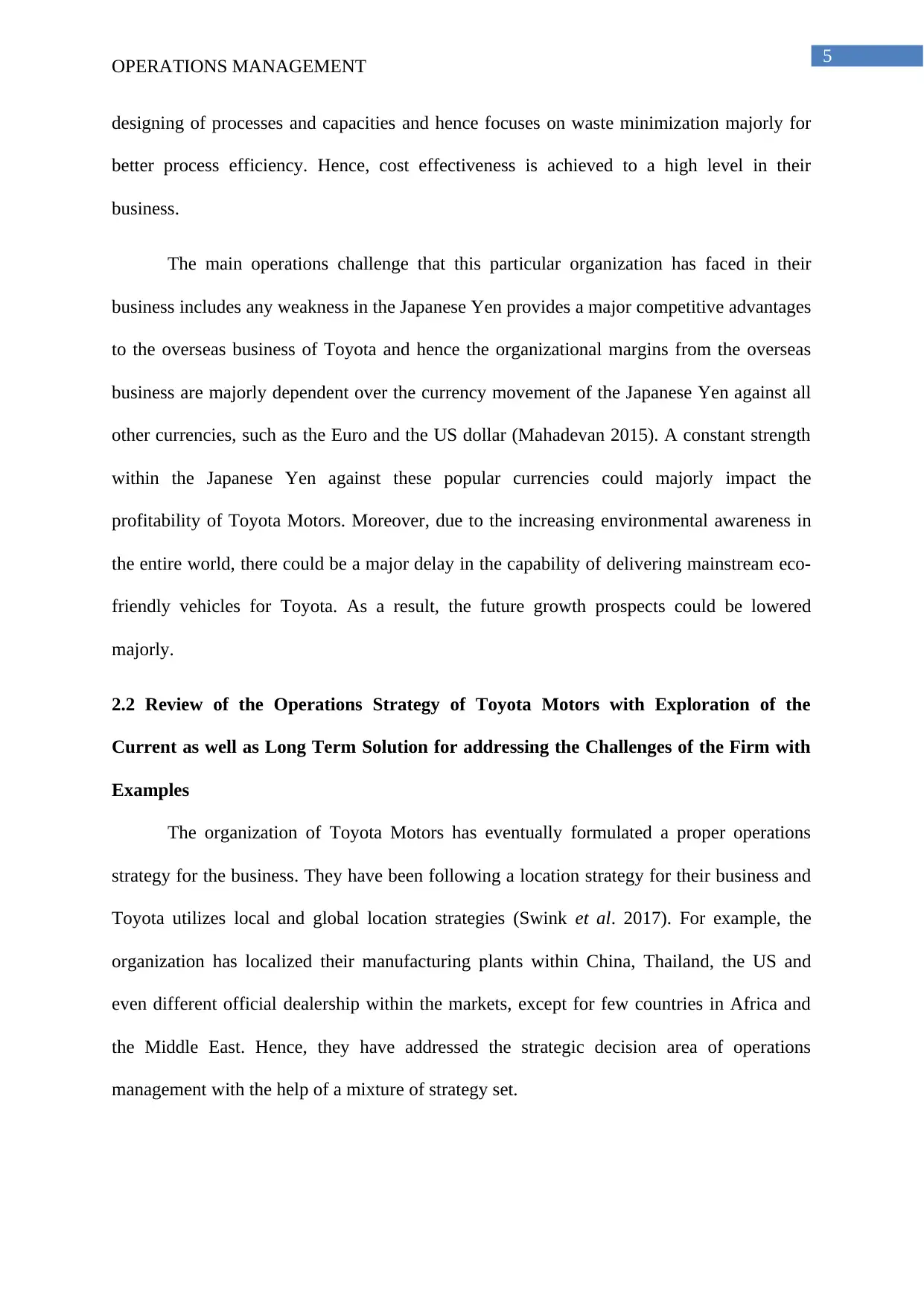
5
OPERATIONS MANAGEMENT
designing of processes and capacities and hence focuses on waste minimization majorly for
better process efficiency. Hence, cost effectiveness is achieved to a high level in their
business.
The main operations challenge that this particular organization has faced in their
business includes any weakness in the Japanese Yen provides a major competitive advantages
to the overseas business of Toyota and hence the organizational margins from the overseas
business are majorly dependent over the currency movement of the Japanese Yen against all
other currencies, such as the Euro and the US dollar (Mahadevan 2015). A constant strength
within the Japanese Yen against these popular currencies could majorly impact the
profitability of Toyota Motors. Moreover, due to the increasing environmental awareness in
the entire world, there could be a major delay in the capability of delivering mainstream eco-
friendly vehicles for Toyota. As a result, the future growth prospects could be lowered
majorly.
2.2 Review of the Operations Strategy of Toyota Motors with Exploration of the
Current as well as Long Term Solution for addressing the Challenges of the Firm with
Examples
The organization of Toyota Motors has eventually formulated a proper operations
strategy for the business. They have been following a location strategy for their business and
Toyota utilizes local and global location strategies (Swink et al. 2017). For example, the
organization has localized their manufacturing plants within China, Thailand, the US and
even different official dealership within the markets, except for few countries in Africa and
the Middle East. Hence, they have addressed the strategic decision area of operations
management with the help of a mixture of strategy set.
OPERATIONS MANAGEMENT
designing of processes and capacities and hence focuses on waste minimization majorly for
better process efficiency. Hence, cost effectiveness is achieved to a high level in their
business.
The main operations challenge that this particular organization has faced in their
business includes any weakness in the Japanese Yen provides a major competitive advantages
to the overseas business of Toyota and hence the organizational margins from the overseas
business are majorly dependent over the currency movement of the Japanese Yen against all
other currencies, such as the Euro and the US dollar (Mahadevan 2015). A constant strength
within the Japanese Yen against these popular currencies could majorly impact the
profitability of Toyota Motors. Moreover, due to the increasing environmental awareness in
the entire world, there could be a major delay in the capability of delivering mainstream eco-
friendly vehicles for Toyota. As a result, the future growth prospects could be lowered
majorly.
2.2 Review of the Operations Strategy of Toyota Motors with Exploration of the
Current as well as Long Term Solution for addressing the Challenges of the Firm with
Examples
The organization of Toyota Motors has eventually formulated a proper operations
strategy for the business. They have been following a location strategy for their business and
Toyota utilizes local and global location strategies (Swink et al. 2017). For example, the
organization has localized their manufacturing plants within China, Thailand, the US and
even different official dealership within the markets, except for few countries in Africa and
the Middle East. Hence, they have addressed the strategic decision area of operations
management with the help of a mixture of strategy set.
⊘ This is a preview!⊘
Do you want full access?
Subscribe today to unlock all pages.

Trusted by 1+ million students worldwide
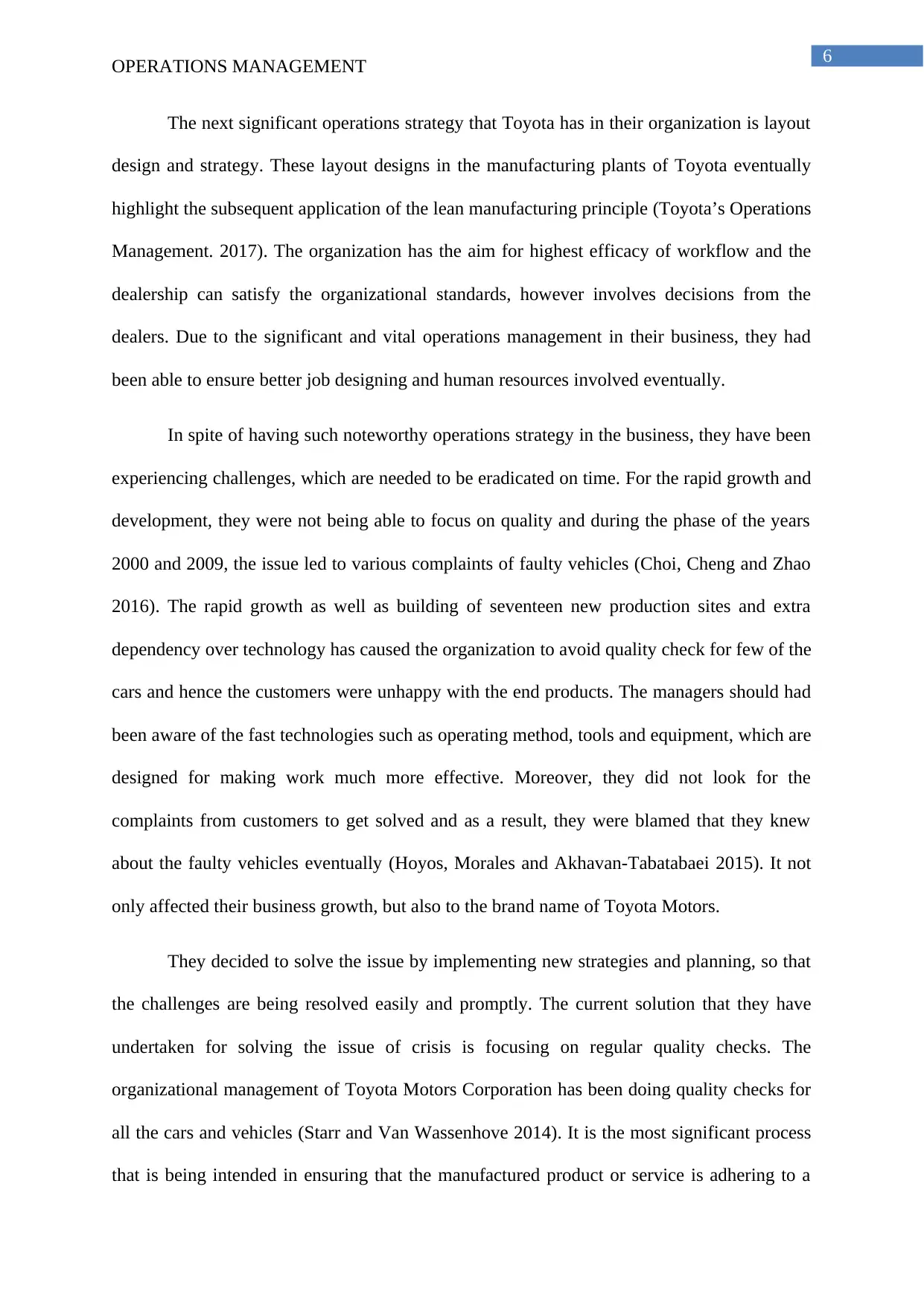
6
OPERATIONS MANAGEMENT
The next significant operations strategy that Toyota has in their organization is layout
design and strategy. These layout designs in the manufacturing plants of Toyota eventually
highlight the subsequent application of the lean manufacturing principle (Toyota’s Operations
Management. 2017). The organization has the aim for highest efficacy of workflow and the
dealership can satisfy the organizational standards, however involves decisions from the
dealers. Due to the significant and vital operations management in their business, they had
been able to ensure better job designing and human resources involved eventually.
In spite of having such noteworthy operations strategy in the business, they have been
experiencing challenges, which are needed to be eradicated on time. For the rapid growth and
development, they were not being able to focus on quality and during the phase of the years
2000 and 2009, the issue led to various complaints of faulty vehicles (Choi, Cheng and Zhao
2016). The rapid growth as well as building of seventeen new production sites and extra
dependency over technology has caused the organization to avoid quality check for few of the
cars and hence the customers were unhappy with the end products. The managers should had
been aware of the fast technologies such as operating method, tools and equipment, which are
designed for making work much more effective. Moreover, they did not look for the
complaints from customers to get solved and as a result, they were blamed that they knew
about the faulty vehicles eventually (Hoyos, Morales and Akhavan-Tabatabaei 2015). It not
only affected their business growth, but also to the brand name of Toyota Motors.
They decided to solve the issue by implementing new strategies and planning, so that
the challenges are being resolved easily and promptly. The current solution that they have
undertaken for solving the issue of crisis is focusing on regular quality checks. The
organizational management of Toyota Motors Corporation has been doing quality checks for
all the cars and vehicles (Starr and Van Wassenhove 2014). It is the most significant process
that is being intended in ensuring that the manufactured product or service is adhering to a
OPERATIONS MANAGEMENT
The next significant operations strategy that Toyota has in their organization is layout
design and strategy. These layout designs in the manufacturing plants of Toyota eventually
highlight the subsequent application of the lean manufacturing principle (Toyota’s Operations
Management. 2017). The organization has the aim for highest efficacy of workflow and the
dealership can satisfy the organizational standards, however involves decisions from the
dealers. Due to the significant and vital operations management in their business, they had
been able to ensure better job designing and human resources involved eventually.
In spite of having such noteworthy operations strategy in the business, they have been
experiencing challenges, which are needed to be eradicated on time. For the rapid growth and
development, they were not being able to focus on quality and during the phase of the years
2000 and 2009, the issue led to various complaints of faulty vehicles (Choi, Cheng and Zhao
2016). The rapid growth as well as building of seventeen new production sites and extra
dependency over technology has caused the organization to avoid quality check for few of the
cars and hence the customers were unhappy with the end products. The managers should had
been aware of the fast technologies such as operating method, tools and equipment, which are
designed for making work much more effective. Moreover, they did not look for the
complaints from customers to get solved and as a result, they were blamed that they knew
about the faulty vehicles eventually (Hoyos, Morales and Akhavan-Tabatabaei 2015). It not
only affected their business growth, but also to the brand name of Toyota Motors.
They decided to solve the issue by implementing new strategies and planning, so that
the challenges are being resolved easily and promptly. The current solution that they have
undertaken for solving the issue of crisis is focusing on regular quality checks. The
organizational management of Toyota Motors Corporation has been doing quality checks for
all the cars and vehicles (Starr and Van Wassenhove 2014). It is the most significant process
that is being intended in ensuring that the manufactured product or service is adhering to a
Paraphrase This Document
Need a fresh take? Get an instant paraphrase of this document with our AI Paraphraser
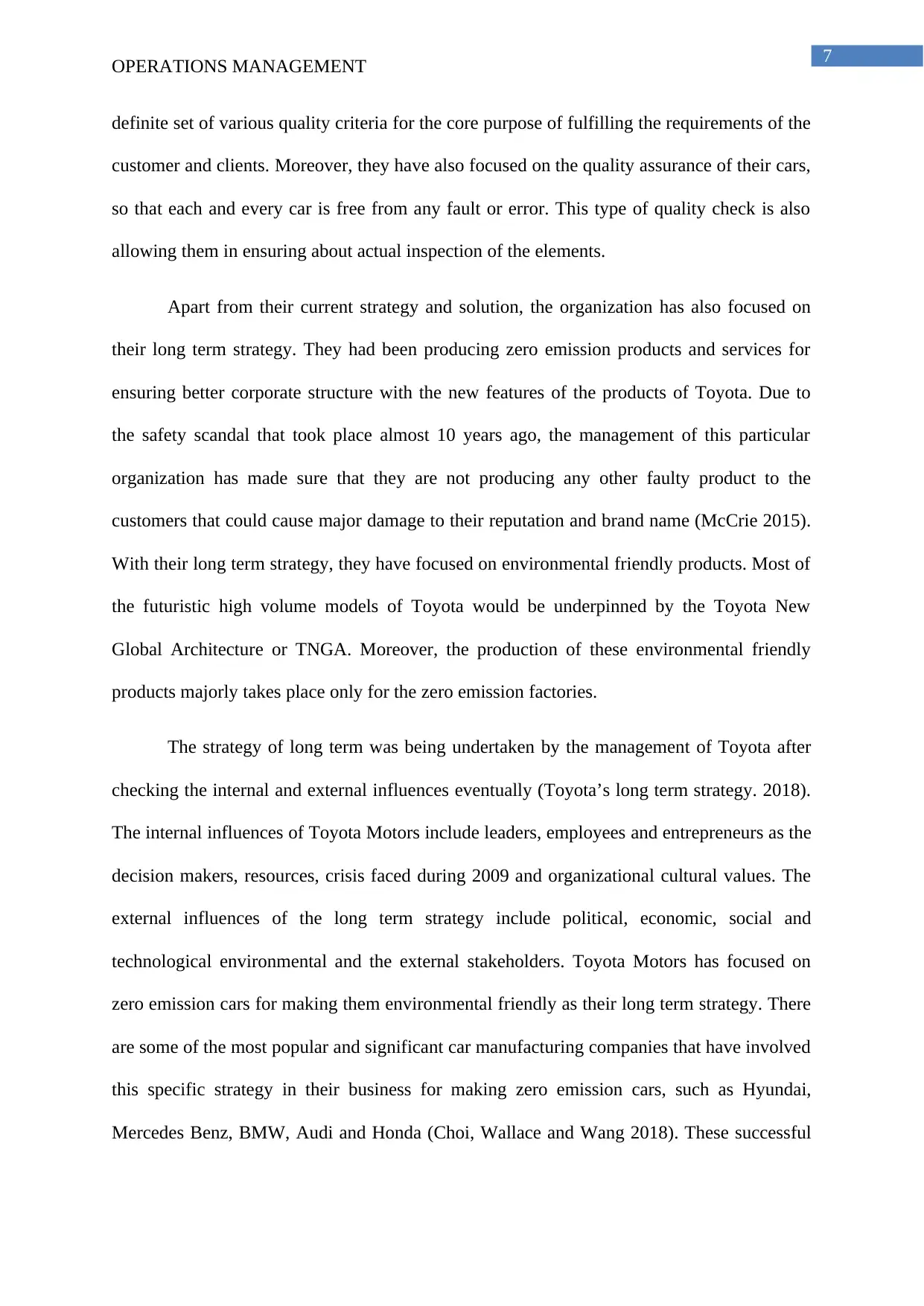
7
OPERATIONS MANAGEMENT
definite set of various quality criteria for the core purpose of fulfilling the requirements of the
customer and clients. Moreover, they have also focused on the quality assurance of their cars,
so that each and every car is free from any fault or error. This type of quality check is also
allowing them in ensuring about actual inspection of the elements.
Apart from their current strategy and solution, the organization has also focused on
their long term strategy. They had been producing zero emission products and services for
ensuring better corporate structure with the new features of the products of Toyota. Due to
the safety scandal that took place almost 10 years ago, the management of this particular
organization has made sure that they are not producing any other faulty product to the
customers that could cause major damage to their reputation and brand name (McCrie 2015).
With their long term strategy, they have focused on environmental friendly products. Most of
the futuristic high volume models of Toyota would be underpinned by the Toyota New
Global Architecture or TNGA. Moreover, the production of these environmental friendly
products majorly takes place only for the zero emission factories.
The strategy of long term was being undertaken by the management of Toyota after
checking the internal and external influences eventually (Toyota’s long term strategy. 2018).
The internal influences of Toyota Motors include leaders, employees and entrepreneurs as the
decision makers, resources, crisis faced during 2009 and organizational cultural values. The
external influences of the long term strategy include political, economic, social and
technological environmental and the external stakeholders. Toyota Motors has focused on
zero emission cars for making them environmental friendly as their long term strategy. There
are some of the most popular and significant car manufacturing companies that have involved
this specific strategy in their business for making zero emission cars, such as Hyundai,
Mercedes Benz, BMW, Audi and Honda (Choi, Wallace and Wang 2018). These successful
OPERATIONS MANAGEMENT
definite set of various quality criteria for the core purpose of fulfilling the requirements of the
customer and clients. Moreover, they have also focused on the quality assurance of their cars,
so that each and every car is free from any fault or error. This type of quality check is also
allowing them in ensuring about actual inspection of the elements.
Apart from their current strategy and solution, the organization has also focused on
their long term strategy. They had been producing zero emission products and services for
ensuring better corporate structure with the new features of the products of Toyota. Due to
the safety scandal that took place almost 10 years ago, the management of this particular
organization has made sure that they are not producing any other faulty product to the
customers that could cause major damage to their reputation and brand name (McCrie 2015).
With their long term strategy, they have focused on environmental friendly products. Most of
the futuristic high volume models of Toyota would be underpinned by the Toyota New
Global Architecture or TNGA. Moreover, the production of these environmental friendly
products majorly takes place only for the zero emission factories.
The strategy of long term was being undertaken by the management of Toyota after
checking the internal and external influences eventually (Toyota’s long term strategy. 2018).
The internal influences of Toyota Motors include leaders, employees and entrepreneurs as the
decision makers, resources, crisis faced during 2009 and organizational cultural values. The
external influences of the long term strategy include political, economic, social and
technological environmental and the external stakeholders. Toyota Motors has focused on
zero emission cars for making them environmental friendly as their long term strategy. There
are some of the most popular and significant car manufacturing companies that have involved
this specific strategy in their business for making zero emission cars, such as Hyundai,
Mercedes Benz, BMW, Audi and Honda (Choi, Wallace and Wang 2018). These successful
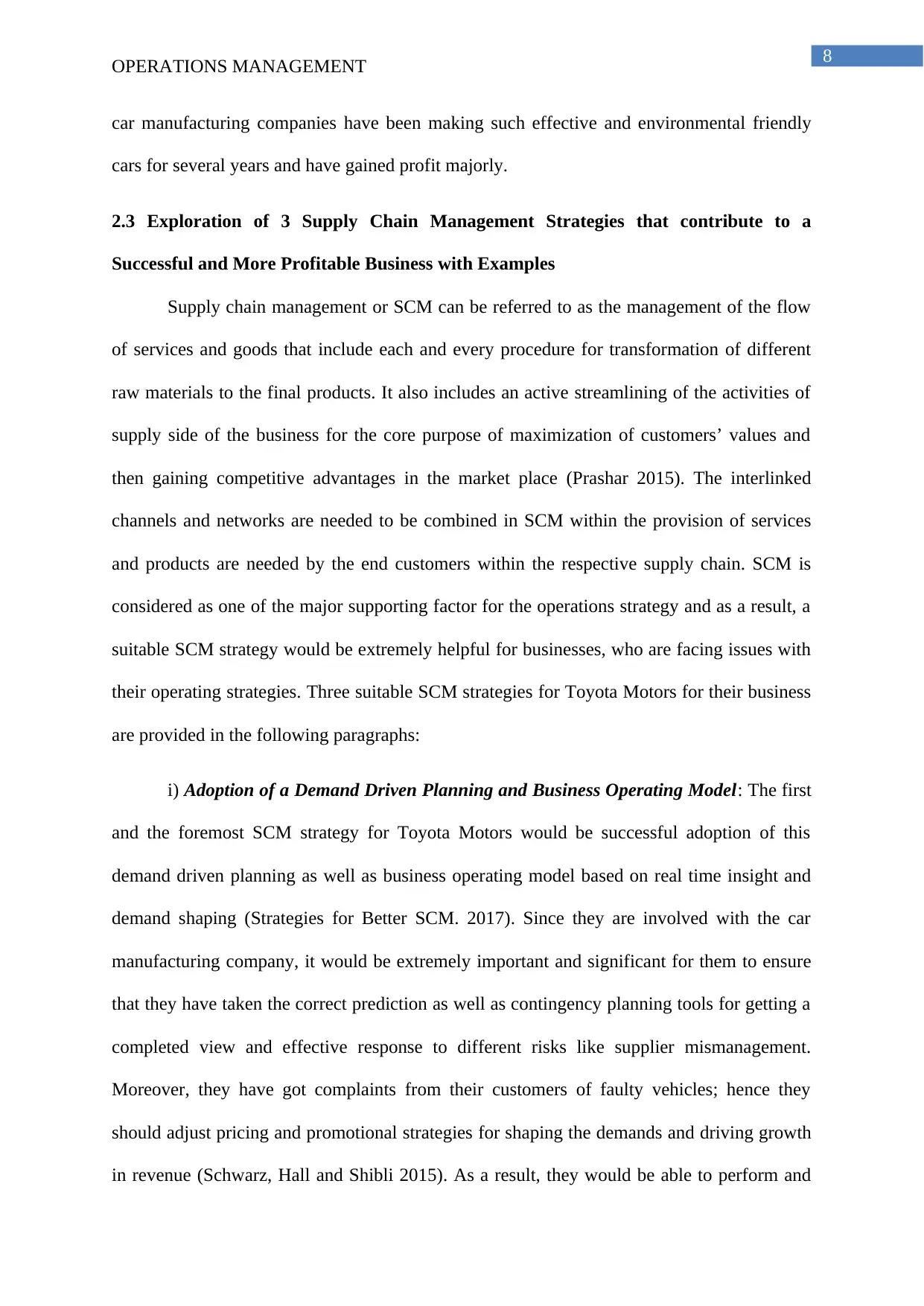
8
OPERATIONS MANAGEMENT
car manufacturing companies have been making such effective and environmental friendly
cars for several years and have gained profit majorly.
2.3 Exploration of 3 Supply Chain Management Strategies that contribute to a
Successful and More Profitable Business with Examples
Supply chain management or SCM can be referred to as the management of the flow
of services and goods that include each and every procedure for transformation of different
raw materials to the final products. It also includes an active streamlining of the activities of
supply side of the business for the core purpose of maximization of customers’ values and
then gaining competitive advantages in the market place (Prashar 2015). The interlinked
channels and networks are needed to be combined in SCM within the provision of services
and products are needed by the end customers within the respective supply chain. SCM is
considered as one of the major supporting factor for the operations strategy and as a result, a
suitable SCM strategy would be extremely helpful for businesses, who are facing issues with
their operating strategies. Three suitable SCM strategies for Toyota Motors for their business
are provided in the following paragraphs:
i) Adoption of a Demand Driven Planning and Business Operating Model: The first
and the foremost SCM strategy for Toyota Motors would be successful adoption of this
demand driven planning as well as business operating model based on real time insight and
demand shaping (Strategies for Better SCM. 2017). Since they are involved with the car
manufacturing company, it would be extremely important and significant for them to ensure
that they have taken the correct prediction as well as contingency planning tools for getting a
completed view and effective response to different risks like supplier mismanagement.
Moreover, they have got complaints from their customers of faulty vehicles; hence they
should adjust pricing and promotional strategies for shaping the demands and driving growth
in revenue (Schwarz, Hall and Shibli 2015). As a result, they would be able to perform and
OPERATIONS MANAGEMENT
car manufacturing companies have been making such effective and environmental friendly
cars for several years and have gained profit majorly.
2.3 Exploration of 3 Supply Chain Management Strategies that contribute to a
Successful and More Profitable Business with Examples
Supply chain management or SCM can be referred to as the management of the flow
of services and goods that include each and every procedure for transformation of different
raw materials to the final products. It also includes an active streamlining of the activities of
supply side of the business for the core purpose of maximization of customers’ values and
then gaining competitive advantages in the market place (Prashar 2015). The interlinked
channels and networks are needed to be combined in SCM within the provision of services
and products are needed by the end customers within the respective supply chain. SCM is
considered as one of the major supporting factor for the operations strategy and as a result, a
suitable SCM strategy would be extremely helpful for businesses, who are facing issues with
their operating strategies. Three suitable SCM strategies for Toyota Motors for their business
are provided in the following paragraphs:
i) Adoption of a Demand Driven Planning and Business Operating Model: The first
and the foremost SCM strategy for Toyota Motors would be successful adoption of this
demand driven planning as well as business operating model based on real time insight and
demand shaping (Strategies for Better SCM. 2017). Since they are involved with the car
manufacturing company, it would be extremely important and significant for them to ensure
that they have taken the correct prediction as well as contingency planning tools for getting a
completed view and effective response to different risks like supplier mismanagement.
Moreover, they have got complaints from their customers of faulty vehicles; hence they
should adjust pricing and promotional strategies for shaping the demands and driving growth
in revenue (Schwarz, Hall and Shibli 2015). As a result, they would be able to perform and
⊘ This is a preview!⊘
Do you want full access?
Subscribe today to unlock all pages.

Trusted by 1+ million students worldwide
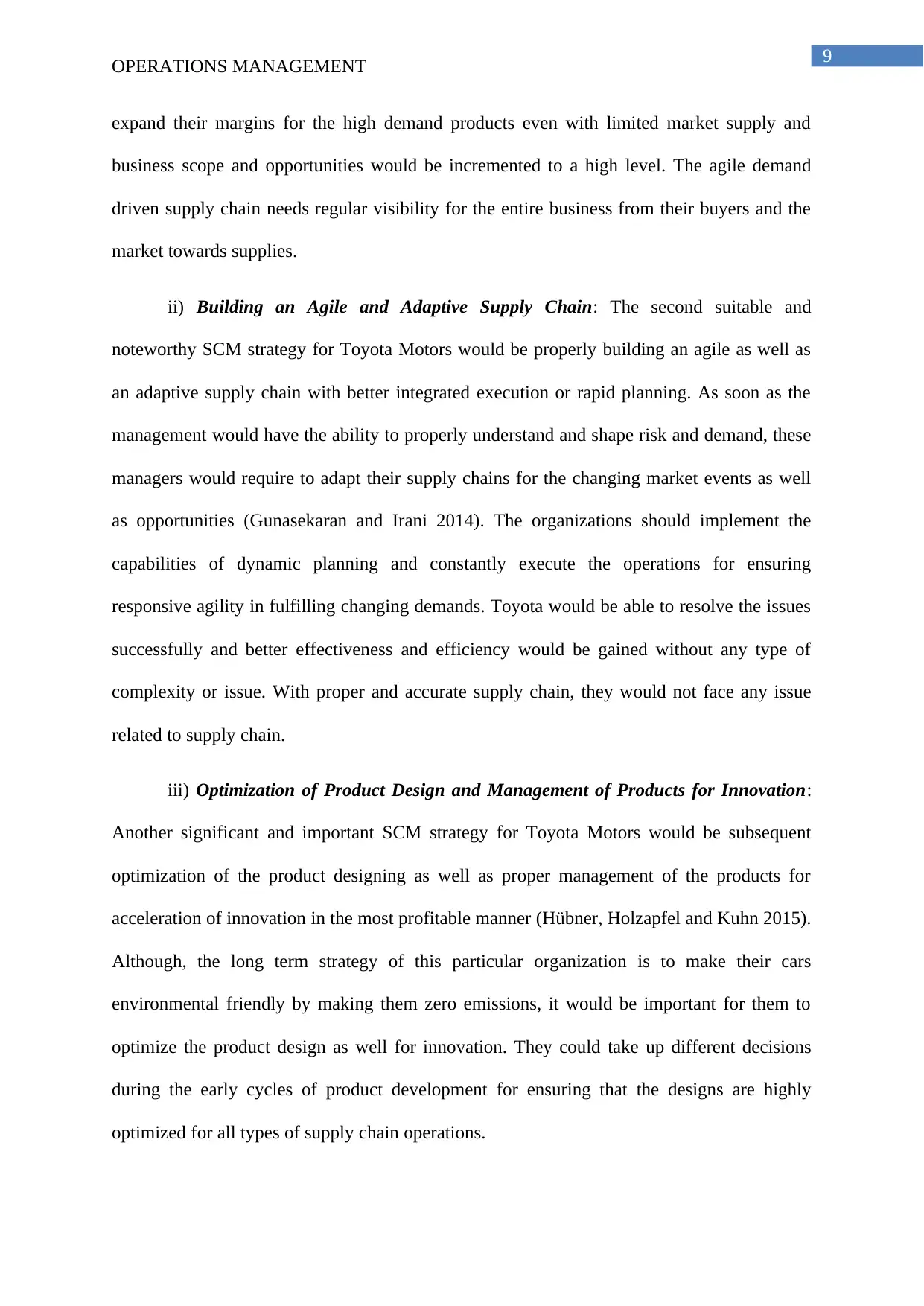
9
OPERATIONS MANAGEMENT
expand their margins for the high demand products even with limited market supply and
business scope and opportunities would be incremented to a high level. The agile demand
driven supply chain needs regular visibility for the entire business from their buyers and the
market towards supplies.
ii) Building an Agile and Adaptive Supply Chain: The second suitable and
noteworthy SCM strategy for Toyota Motors would be properly building an agile as well as
an adaptive supply chain with better integrated execution or rapid planning. As soon as the
management would have the ability to properly understand and shape risk and demand, these
managers would require to adapt their supply chains for the changing market events as well
as opportunities (Gunasekaran and Irani 2014). The organizations should implement the
capabilities of dynamic planning and constantly execute the operations for ensuring
responsive agility in fulfilling changing demands. Toyota would be able to resolve the issues
successfully and better effectiveness and efficiency would be gained without any type of
complexity or issue. With proper and accurate supply chain, they would not face any issue
related to supply chain.
iii) Optimization of Product Design and Management of Products for Innovation:
Another significant and important SCM strategy for Toyota Motors would be subsequent
optimization of the product designing as well as proper management of the products for
acceleration of innovation in the most profitable manner (Hübner, Holzapfel and Kuhn 2015).
Although, the long term strategy of this particular organization is to make their cars
environmental friendly by making them zero emissions, it would be important for them to
optimize the product design as well for innovation. They could take up different decisions
during the early cycles of product development for ensuring that the designs are highly
optimized for all types of supply chain operations.
OPERATIONS MANAGEMENT
expand their margins for the high demand products even with limited market supply and
business scope and opportunities would be incremented to a high level. The agile demand
driven supply chain needs regular visibility for the entire business from their buyers and the
market towards supplies.
ii) Building an Agile and Adaptive Supply Chain: The second suitable and
noteworthy SCM strategy for Toyota Motors would be properly building an agile as well as
an adaptive supply chain with better integrated execution or rapid planning. As soon as the
management would have the ability to properly understand and shape risk and demand, these
managers would require to adapt their supply chains for the changing market events as well
as opportunities (Gunasekaran and Irani 2014). The organizations should implement the
capabilities of dynamic planning and constantly execute the operations for ensuring
responsive agility in fulfilling changing demands. Toyota would be able to resolve the issues
successfully and better effectiveness and efficiency would be gained without any type of
complexity or issue. With proper and accurate supply chain, they would not face any issue
related to supply chain.
iii) Optimization of Product Design and Management of Products for Innovation:
Another significant and important SCM strategy for Toyota Motors would be subsequent
optimization of the product designing as well as proper management of the products for
acceleration of innovation in the most profitable manner (Hübner, Holzapfel and Kuhn 2015).
Although, the long term strategy of this particular organization is to make their cars
environmental friendly by making them zero emissions, it would be important for them to
optimize the product design as well for innovation. They could take up different decisions
during the early cycles of product development for ensuring that the designs are highly
optimized for all types of supply chain operations.
Paraphrase This Document
Need a fresh take? Get an instant paraphrase of this document with our AI Paraphraser
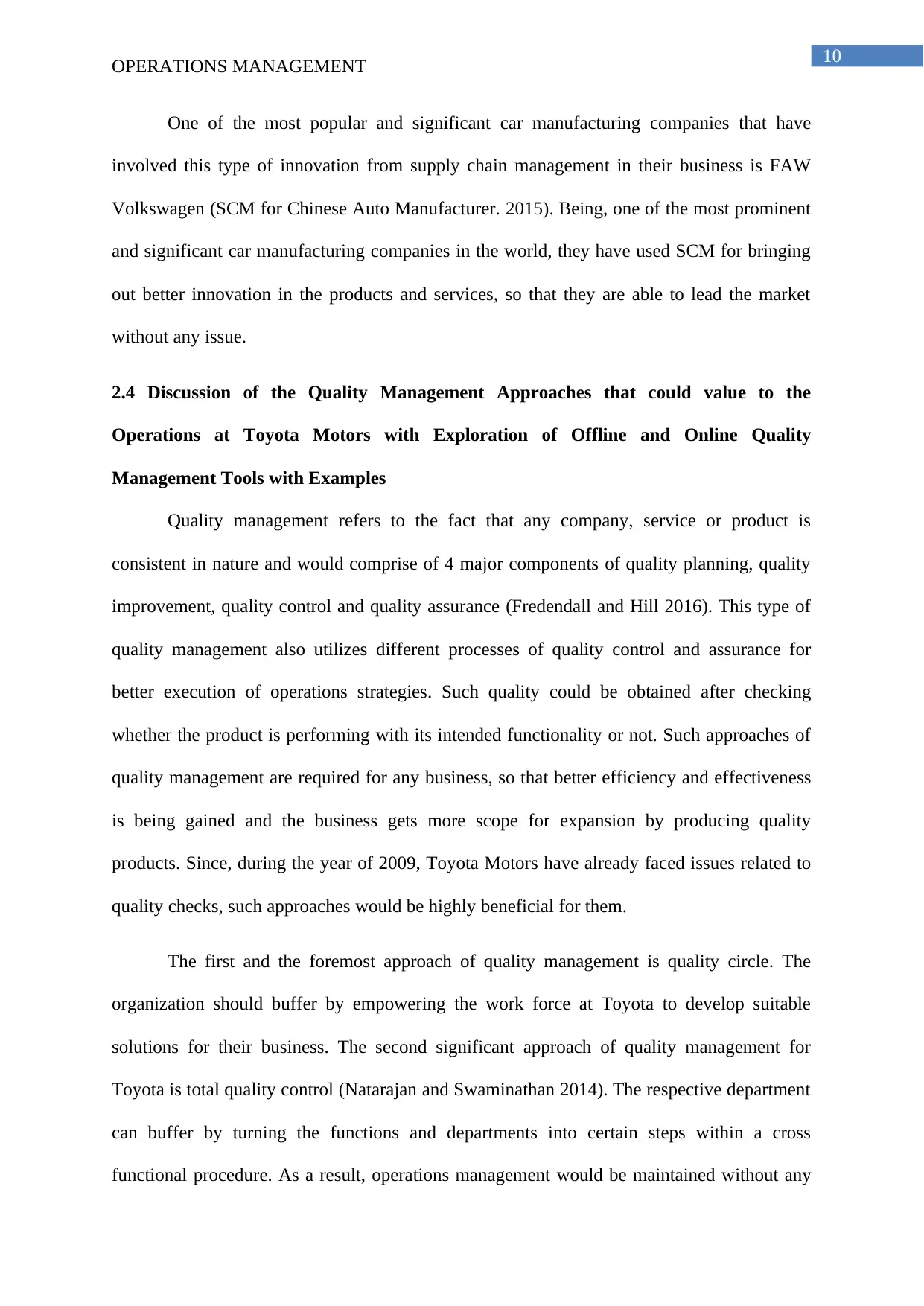
10
OPERATIONS MANAGEMENT
One of the most popular and significant car manufacturing companies that have
involved this type of innovation from supply chain management in their business is FAW
Volkswagen (SCM for Chinese Auto Manufacturer. 2015). Being, one of the most prominent
and significant car manufacturing companies in the world, they have used SCM for bringing
out better innovation in the products and services, so that they are able to lead the market
without any issue.
2.4 Discussion of the Quality Management Approaches that could value to the
Operations at Toyota Motors with Exploration of Offline and Online Quality
Management Tools with Examples
Quality management refers to the fact that any company, service or product is
consistent in nature and would comprise of 4 major components of quality planning, quality
improvement, quality control and quality assurance (Fredendall and Hill 2016). This type of
quality management also utilizes different processes of quality control and assurance for
better execution of operations strategies. Such quality could be obtained after checking
whether the product is performing with its intended functionality or not. Such approaches of
quality management are required for any business, so that better efficiency and effectiveness
is being gained and the business gets more scope for expansion by producing quality
products. Since, during the year of 2009, Toyota Motors have already faced issues related to
quality checks, such approaches would be highly beneficial for them.
The first and the foremost approach of quality management is quality circle. The
organization should buffer by empowering the work force at Toyota to develop suitable
solutions for their business. The second significant approach of quality management for
Toyota is total quality control (Natarajan and Swaminathan 2014). The respective department
can buffer by turning the functions and departments into certain steps within a cross
functional procedure. As a result, operations management would be maintained without any
OPERATIONS MANAGEMENT
One of the most popular and significant car manufacturing companies that have
involved this type of innovation from supply chain management in their business is FAW
Volkswagen (SCM for Chinese Auto Manufacturer. 2015). Being, one of the most prominent
and significant car manufacturing companies in the world, they have used SCM for bringing
out better innovation in the products and services, so that they are able to lead the market
without any issue.
2.4 Discussion of the Quality Management Approaches that could value to the
Operations at Toyota Motors with Exploration of Offline and Online Quality
Management Tools with Examples
Quality management refers to the fact that any company, service or product is
consistent in nature and would comprise of 4 major components of quality planning, quality
improvement, quality control and quality assurance (Fredendall and Hill 2016). This type of
quality management also utilizes different processes of quality control and assurance for
better execution of operations strategies. Such quality could be obtained after checking
whether the product is performing with its intended functionality or not. Such approaches of
quality management are required for any business, so that better efficiency and effectiveness
is being gained and the business gets more scope for expansion by producing quality
products. Since, during the year of 2009, Toyota Motors have already faced issues related to
quality checks, such approaches would be highly beneficial for them.
The first and the foremost approach of quality management is quality circle. The
organization should buffer by empowering the work force at Toyota to develop suitable
solutions for their business. The second significant approach of quality management for
Toyota is total quality control (Natarajan and Swaminathan 2014). The respective department
can buffer by turning the functions and departments into certain steps within a cross
functional procedure. As a result, operations management would be maintained without any
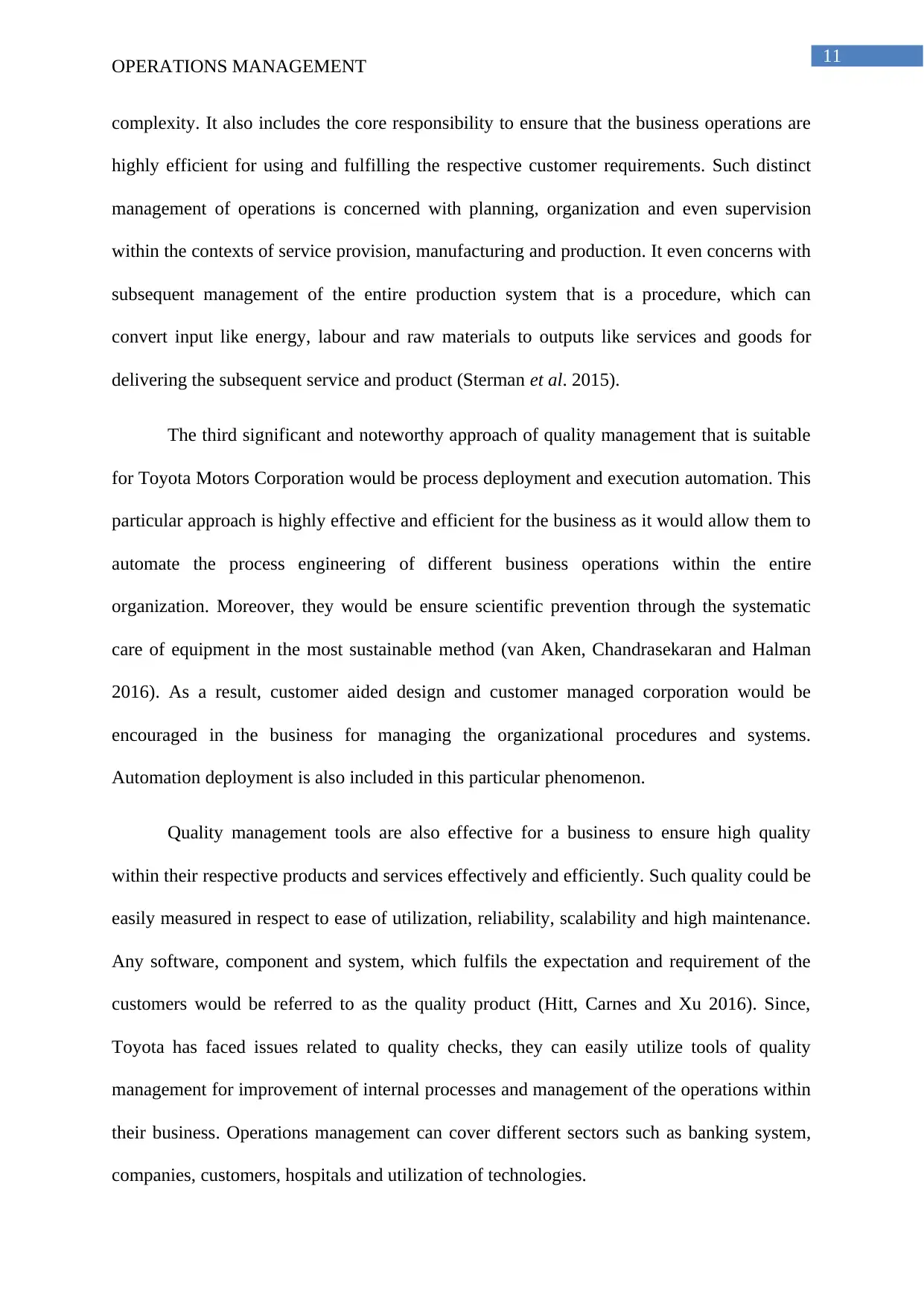
11
OPERATIONS MANAGEMENT
complexity. It also includes the core responsibility to ensure that the business operations are
highly efficient for using and fulfilling the respective customer requirements. Such distinct
management of operations is concerned with planning, organization and even supervision
within the contexts of service provision, manufacturing and production. It even concerns with
subsequent management of the entire production system that is a procedure, which can
convert input like energy, labour and raw materials to outputs like services and goods for
delivering the subsequent service and product (Sterman et al. 2015).
The third significant and noteworthy approach of quality management that is suitable
for Toyota Motors Corporation would be process deployment and execution automation. This
particular approach is highly effective and efficient for the business as it would allow them to
automate the process engineering of different business operations within the entire
organization. Moreover, they would be ensure scientific prevention through the systematic
care of equipment in the most sustainable method (van Aken, Chandrasekaran and Halman
2016). As a result, customer aided design and customer managed corporation would be
encouraged in the business for managing the organizational procedures and systems.
Automation deployment is also included in this particular phenomenon.
Quality management tools are also effective for a business to ensure high quality
within their respective products and services effectively and efficiently. Such quality could be
easily measured in respect to ease of utilization, reliability, scalability and high maintenance.
Any software, component and system, which fulfils the expectation and requirement of the
customers would be referred to as the quality product (Hitt, Carnes and Xu 2016). Since,
Toyota has faced issues related to quality checks, they can easily utilize tools of quality
management for improvement of internal processes and management of the operations within
their business. Operations management can cover different sectors such as banking system,
companies, customers, hospitals and utilization of technologies.
OPERATIONS MANAGEMENT
complexity. It also includes the core responsibility to ensure that the business operations are
highly efficient for using and fulfilling the respective customer requirements. Such distinct
management of operations is concerned with planning, organization and even supervision
within the contexts of service provision, manufacturing and production. It even concerns with
subsequent management of the entire production system that is a procedure, which can
convert input like energy, labour and raw materials to outputs like services and goods for
delivering the subsequent service and product (Sterman et al. 2015).
The third significant and noteworthy approach of quality management that is suitable
for Toyota Motors Corporation would be process deployment and execution automation. This
particular approach is highly effective and efficient for the business as it would allow them to
automate the process engineering of different business operations within the entire
organization. Moreover, they would be ensure scientific prevention through the systematic
care of equipment in the most sustainable method (van Aken, Chandrasekaran and Halman
2016). As a result, customer aided design and customer managed corporation would be
encouraged in the business for managing the organizational procedures and systems.
Automation deployment is also included in this particular phenomenon.
Quality management tools are also effective for a business to ensure high quality
within their respective products and services effectively and efficiently. Such quality could be
easily measured in respect to ease of utilization, reliability, scalability and high maintenance.
Any software, component and system, which fulfils the expectation and requirement of the
customers would be referred to as the quality product (Hitt, Carnes and Xu 2016). Since,
Toyota has faced issues related to quality checks, they can easily utilize tools of quality
management for improvement of internal processes and management of the operations within
their business. Operations management can cover different sectors such as banking system,
companies, customers, hospitals and utilization of technologies.
⊘ This is a preview!⊘
Do you want full access?
Subscribe today to unlock all pages.

Trusted by 1+ million students worldwide
1 out of 20
Related Documents
Your All-in-One AI-Powered Toolkit for Academic Success.
+13062052269
info@desklib.com
Available 24*7 on WhatsApp / Email
![[object Object]](/_next/static/media/star-bottom.7253800d.svg)
Unlock your academic potential
Copyright © 2020–2025 A2Z Services. All Rights Reserved. Developed and managed by ZUCOL.





